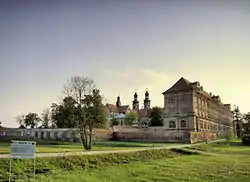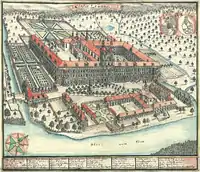Lubiąż Abbey
Lubiąż Abbey (German: Kloster Leubus; Polish: Opactwo cystersów w Lubiążu), also commonly known in English as Leubus Abbey, is a former Cistercian monastery in Lubiąż,[1] in the Lower Silesian Voivodeship of southwestern Poland, located about 54 km (34 mi) northwest of Wrocław. The abbey, established in 1175, is one of the largest Christian architectural complexes in the world and is considered a masterpiece of Baroque Silesian architecture.[2][3]




Description
The area of the roofs is about 25,000 square metres. The façade, with a length of 223 m (732 ft), is the longest in Europe after that of El Escorial in Spain. In the crypts are 98 well-preserved mummies of Silesian dukes.
Built over centuries, the abbey - the biggest Cistercian abbey in the world - is currently rated in the highest class ("0") of landmarks of the world's cultural heritage.
Abbey history
The abbey is situated near a ford across the Oder river, where a Benedictine monastery and church of Saint James may have been established about 1150, but had already been abandoned before 1163. At this time the area belonged to the Duchy of Silesia, bequeathed by Duke Bolesław III Wrymouth of Poland to his eldest son Władysław II in 1138. In a fratricidal conflict of the Polish Piast dynasty, Władysław was expelled by his younger brother and fled to Altenburg in the Holy Roman Empire. With the aid by Emperor Frederick Barbarossa, however, his sons were restored to their Silesian heritage in 1163.
Władysław's eldest son, Duke Bolesław I the Tall, had spent several years in German exile. When he assumed the rule of Lower Silesia, he invited Cistercian monks from Pforta Abbey on the Saale River (in present-day Thuringia) and settled them in Lubiąż as the first of their order in Silesia. The first monastery complex was under construction up to 1175, when Duke Bolesław I issued the official foundation charter at Grodziec Castle. Through drainage works the monks reclaimed land in the swampy environs of the monastery, implemented three-field crop rotation and laid out vineyards. Their efforts were successful and marked the beginning of the medieval German Ostsiedlung to Silesia.
About 1200 the abbey church was rebuilt, at that time the first Brick Gothic building in the region. When Duke Bolesław I died in 1201, he was buried here. The rise of Leubus continued under the rule of his son Duke Henry I the Bearded and his consort Hedwig of Andechs. In 1202 the couple established Trzebnica Abbey, which in 1220 became a daughter house of Leubus by order of Pope Honorius III. It was followed by the establishment in 1222 of Mogiła Abbey (nowadays part of Nowa Huta) in Lesser Poland and Henryków Abbey in 1227. In 1249 the monks of Leubus took over the former Augustinian abbey of Kamieniec and in 1256 even established a monastery at Byszewo in Kuyavia, relocated to Koronowo in 1288.
From 1249 to 1844, the place held town privileges. In 1327 the Silesian duke Henry VI the Good declared himself a vassal of King John of Bohemia, and when he died without male heirs in 1335, his lands including Leubus fell to the Kingdom of Bohemia. The monastery complex was devastated by the Hussite Wars, and furthermore the monks were expelled by warlike Duke Jan II the Mad in 1492, who turned the abbey into a hunting lodge. The Cistercians were not able to return until Jan II retired to Frankfurt an der Oder in Brandenburg. In the 16th century the abbey had to deal with the Protestant Reformation and the inheritance of the Lands of the Bohemian Crown by the Austrian House of Habsburg. During the Thirty Years' War, Leubus was occupied and plundered by Swedish troops in 1638.
The painter Michael Willmann, after his conversion to the Catholic Church, was patronized by the abbey from about 1660 till his death in 1706.[4]
The Cistercians were expelled from Lubiąż in 1810 by King Frederick William III of Prussia.
During World War II, the buildings of the former abbey were used for secret research laboratories and manufacturing facilities, among other things for the development of radar components (by Telefunken), housed a company named "Schlesische Werkstätten Dr. Fürstenau & Co., G.m.b.H.", and then saw production of engines for V1 and V2 rockets (using prisoners for labour). At the end of the war, the former abbey housed soldiers of the Red Army, and then a Russian military psychiatric hospital, with significant damage (e.g., wooden furnishings were burned in stoves). Decades of neglect followed.[5]
Since 1989, the abbey has been under renovation and has become a significant tourist destination. As of 2020, the renovation is not yet complete.[5]
Burials
References
- Herbermann, Charles, ed. (1913). . Catholic Encyclopedia. New York: Robert Appleton Company.
- Andrzej Kozieł (2008). Opactwo Cystersów w Lubiążu i artyści. Wydawnictwo Uniwersytetu Wrocławskiego. p. 100. ISBN 978-83-229-2900-1.
- Kaczmar, Małgorzata (2009-02-13). "Klasztor w Lubiążu to prawdziwa architektoniczna perełka baroku". Gazeta Wrocławska (in Polish). Retrieved 2020-03-19.
- Jagiełło, Jakub (March 2011). "Michael Willmann". Culture.pl. Retrieved 2020-03-18.
- Maciejewska, Beata (9 February 2020). "Olbrzymie opactwo cysterskie, którym zainteresowany był Michael Jackson, czeka na wyrok. Miało je przejąć państwo, ale nic nie robi". wroclaw.wyborcza.pl. Retrieved 2020-03-19.
External links
Gallery
 The main facade
The main facade Main refectory
Main refectory Summer refectory
Summer refectory Interior of the church
Interior of the church One of the corridors
One of the corridors
| Wikimedia Commons has media related to Cistercian Abbey of Lubiąż. |
- Attribution
![]() This article incorporates text from a publication now in the public domain: Herbermann, Charles, ed. (1913). "Leubus". Catholic Encyclopedia. New York: Robert Appleton Company.
This article incorporates text from a publication now in the public domain: Herbermann, Charles, ed. (1913). "Leubus". Catholic Encyclopedia. New York: Robert Appleton Company.